The 49ers, first USAAF fighter group to deploy to combat in the Pacific
Today's Air Force has decided to emphasize its history as a means of unit inspiration. This has resulted in units with real “history” as the service decides which unit designations will continue in active service, so that one finds the 1st Fighter Group - which is the lineal descendant of the Lafayette Escadrille and Eddie Rickenbacker's 94th "Hat in the Ring Squadron - in service. Other units famous in history include the 4th Tactical Fighter Wing - the descendants of the Eagle Squadrons and the 4th Fighter Group; the 23rd Tactical Fighter Wing (Composite), the descendants of the American Volunteer Group; and the 49th Fighter Group, descendants of the first organized American fighter group to enter combat in the Second World War. (Yes, The 17th Pursuit Group and 35th Pursuit Group were active in the Philippines, but they were quickly decimated as the Japanese overran the Western Pacific and neither was ever able to really operate as a group.)
The history of the first six months of the 49th Fighter Group in combat - when they were the first line of defense of Australia against Japanese invasion - is a record of achievement in the face of overwhelming odds beyond merely fighting a well-trained, well-equipped, victorious enemy. It is this record that fully places the 49th Fighter Group in the same tradition as the 1st, 23rd, and 4th Groups.
The “49'ers” - as they became known - began life as part of the struggle by the U.S. Army Air Corps to expand itself into the organization everyone knew was going to be needed in the war all saw coming. Major Glen Davasher took command of the newly-organized 49th Pursuit Group on November 20, 1940 at Selfridge Air Base. The 49th was formed from cadre from the 94th Pursuit Group. The three squadrons were the 7th Squadron, who would take the name "Screamin' Demons", the 8th Squadron known as the "Blacksheep," and the 9th Squadron, which adopted the name "Flying Knights."
In May, 1941, the unit transferred to Morrison airfield at West Palm Beach, where the weather was better for the training the pilots needed. Each squadron was equipped with a PT-17 Stearman, a BT-13 Basic Trainer for further instrument work, three P-35 Seversky Advanced Trainer fighter aircraft and one P-40C for training purposes.
Following the attack on Pearl Harbor and the entry of the United States into the Second World War, Major Paul “Squeeze” Wurtsmith took command of the 49th PG on December 12, 1941. The men knew they were going into combat - the only question was when they would leave and where they would go. They read the papers and followed the desperate struggles of the American forces in the Philippines. Rumors spread through the unit as they were notified at the end of the month to begin preparation for overseas deployment that they were going to reinforce the Philippines.
On January 4, 1942, the unit took trains for California, arriving in San Francisco on January 8, where they stayed in the County Livestock Pavilion, affectionately known as the "Cow Palace". While in San Francisco 75 new pilots and 587 more enlisted men joined up to bring the unit to full authorized strength.
Among these 75 youthful officers was a young North Carolinian from Greensboro, 2nd Lt. George E. Preddy, who had fallen in love with flying when he took his first flight on his birthday in 1938, and learned to fly over the following year, getting hold of an old Fleet biplane, with which he barnstormed around the southeastern United States when he was off from college. In 1940, when he had two years of college and qualified for the Navy's NavCad program, he volunteered three times as the program was expanded, to be turned down each time. That fall he enlisted in the Army and served in the 252nd Coast Artillery Battalion. In April 1941, he received orders to report to flight training and graduated on December 12, 1941, the same day Major Wurtsmith took command of the 49th Pursuit Group. Among Preddy's fellow graduates was a young Texan named John Landers, who also received order to the 49th Pursuit Group.
On January 10, the 49th Pursuit Group received their embarkment orders and two days later they boarded the transports Mariposa and Coolidge, while their heavy equipment was loaded aboard the freighter Luckenbach. The ships cast off and headed out under the Golden Gate Bridge at mid-day. Two hours later, outside the sight of land, they rendezvoused with the light cruiser USS Phoenix, and set course toward the western Pacific.
The rumors had been right that they were headed for the Philippines. However, following MacArthur's evacuation of Manila and retreat to Bataan, their final destination was changed on January 28 to Melbourne, Australia. On January 31 they sighted the Australian coastline at Cape Howes, and arrived in Melbourne on February 1.
The unit was first based at several sites around Melbourne, where most were bivouacked under tents. Australia was nervous, as was everywhere else in Southeast Asia as the Japanese stormed south, smashing all opposition.
When Major Wurtsmith reported to American headquarters, he found he'd been promoted to Lt. Col., and his squadron commanders had all been promoted to Captain. The 49th Pursuit Group was the first American unit to arrive in Australia as a complete organization. Over the next three days, after Australian longshoremen refused to unload the ships due to a strike, the officers and men unloaded all their supplies and equipment by hand. Welcome to the war.
All eyes were now on the Dutch East Indies, the newest front against the Japanese, with the fall of Singapore. P-40s and B-25s, originally headed for the Philippines, had been diverted to Brisbane and Townsville. The plan was that, once assembled, they would be flown to Brisbane on the east coast, then on to Charleville, then to Cloncurry in Queensland and finally on to Darwin, from whence they would fly direct to the Indies and on to Java. The route was called “the Brereton Route" and was 3,600 miles long. It was later described to a pilot of the 49th: "You won't have any trouble finding your way to Darwin. Just follow the trail of crashed Kittyhawks. You can't go wrong." It was the equivalent of flying from Boston to Houston, around the coastline of the United States, with no maps and no navigation aids.
The only USAAF unit to make it from Melbourne to Java via the “Brereton route” were 17 P-40s of the 17th Pursuit Group (Provisional). Formed from evacuated survivors from the debacle of the Philippines, 34 aircraft set out to fly to Java; only 17 made it all the way. In the face of this, the decision was made to ship other P-40Es with their pilots and ground crews aboard the aircraft ferry USS Langley, the US Navy's first aircraft carrier, which had been converted to an aircraft ferry. The need was so great that 33 P-40Es newly assigned to the 49th Pursuit Group were flown to Perth for this operation. Once in Perth, they were towed over main roads to Fremantle and loaded on the Langley on February 12. Five days after leaving Australia, the Langley was attacked south of Tilatjap, Java, by Japanese aircraft that damaged her so badly she was torpedoed by an escort. 31 pilots and 12 crew chiefs from the 35th Pursuit Group were among the missing, as well as all 33 P-40Es. Java fell by the end of the month. Australia was next in the line of fire.
The Australian Army and Air Force were in combat in North Africa and could not be withdrawn for defense of the homeland. Only a few second-line squadrons of the RAAF and training units of the Australian Army, existed at this point in Australia. The 49th Fighter Group was all there was to defend a continent.
The Japanese threat became reality on February 19, a week after the sinking of the Langley, when JNAF units first raided Darwin.. In response, an advance team of the49th was flown to from Williamtown to Darwin in an RAAF flying boat.
An 80 man team was sent to Amberley airfield west of Brisbane to support the aerial reinforcement of northern Australia. Ferry pilots began to deliver Kittyhawks to the three squadrons at Bankstown, Fairbairn and Williamtown. Each received 25 Curtiss P-40E Kittyhawks from the first three production runs, in addition to some P-40E-1CU Kittyhawk Is desoignated for Lend-Lease from the 4th production run. All these aircraft carried the star-in-circle insignia and "US Army," though the Lend-Lease aircraft still had their RAF serials. Within two weeks, 30 P-40Es had been wrecked during training, proving AVG ace Charles Older right in his description of the P-40 as an airplane one did not want to have to land in an emergency, due to its narrow-track landing gear.
After the fall of Java, the 49th Pursuit Group acquired a number of experienced airmen. Captains Nate Blanton and Bill Hennon, along with Lieutenant Lester Johnsen became new flight leaders in the 7th Pursuit Squadron, while the 8th Pursuit Squadron was glad to have new Flight Leaders Captain Allison W. Strauss and George Kiser, while Lieutenants R.C. Dockstader and Jim Morehead became element leaders. The 9th Squadron was glad to welcome Captain "Bitchin" Ben Irvin, while Lieutenants Joe Kruzel and Andy Reynolds became element leaders. George Preddy was glad to become Kruzel's wingman in what would eventually become “The Green Dragon Flight” with his friend John Landers.
The 49th Pursuit Group began advancing toward their destiny on March 4, 1942, when Group CO Wurtsmith asked 7th PS CO Captain Morrissey how many pilots were combat ready. His answer was that 11 pilots were ready. Five days later, Morrissey and his 11 men left Bankstown, headed for Horn Island. Since there was no ground support between Bankstown and Darwin, the line chief issued each pilot a small tool kit with spark plugs and simple instructions, while the armorers also instructed the pilots on how to load the six .50" caliber wing guns.
Using road maps to find their way to Brisbane, the pilots of 7th Squadron then used maritime maps to find their way up the Queensland coast. Three of the P-40Es had to divert to Charters Towers due to mechanical problems. The nine remaining Kittyhawks stayed overnight in Townsville, flying on to Iron Range airfield on the 8th, to finally arrive at Horn Island at the tip of Cape York that afternoon. They parked their aircraft at the southern end of the shorter runway and set up their tents in the bush beside the airfield. The next day they began flying patrols within sight of the airfield.
On March 8, Captain James Selman led 25 Kittyhawks of the 9th Pursuit Squadron from Williamtown to follow “The Brereton Route" to Darwin. Among the young pilots were George Preddy and John Landers. They flew to Brisbane, where they left two P-40s behind with engine trouble, then flew on to Charleville where the 23 remaining Kittyhawks left twomore aircraft with mechanical problems. 21 P-40Es pressed on for Cloncurry, led by a B-17. Two more were lost at Cloncurry due to heavy landings, and 19 P-40s flew on to Daly waters on March 14, where four more aircraft became separated in heavy thunderstorms. 15 P-40s landed at Daly Waters between passing rain storms. A three day delay at Daly Waters allowed needed repairs to be made to the P-40s.
Of the 25 P-40Es that had left Williamtown on March 8, 13 finally arrived at Darwin on March 18. They received orders to start operational patrols immediately. After assessing damage at Darwin airfield caused by the many Japanese bombing raids, the squadron moved to Batchelor airfield, 50 miles south of Darwin. During March more Kittyhawks flew “The Brereton Route" to Darwin; by the end of the month the 9th PS had 21 Kittyhawks and 25 pilots. They were the front line of defense of Australia.
The 49th Pursuit Group entered combat on March 14,1942, when P-40s of the 7th Pursuit Squadron claimed 4 Zeros and 1 Betty in a raid on Horn Island. One P-40 rammed one of the Zeros and made a forced landing at Horn Island with 3 feet of its wingtip missing - proof of the P-40's toughness. During early April, other combat veterans of the fighting in the Philippines joined the 9th Squadron at Darwin.
During their time at Darwin, Lt. Joe Kruzel was promoted to flight commander and took his wingman, Preddy, with along with John Landers as number four. With a Green Dragon painted on their noses, the flight entered combat on several occasions. Preddy, as a wingman, with a flight commander who enforced aerial discipline, was only able to score two probables in four months.
July 12, 1942, was a slow day at Darwin. When no strikes had materialized by noon, Kruzel decided it was a good day for training. That afternoon, four junior pilots of the 9th Fighter Squadron (their terminology had changed from “Pursuit” to “Fighter” in May1942) took part in a training flight over Manton Reservoir. The pilots were:- 2nd. Lt. John Sauber, 2nd. Lt. George Preddy, Lt. Jack Donalson and 2nd Lt. Deems Taylor. Sauber, wingman of Blue Flight leader, instructed Preddy that he would simulate an attack, in which Preddy would show the appropriate escape maneuver. Sauber dove on Preddy, but misjudged his separation and the two collided. Sauber was most likely killed on impact and his Kittyhawk - #87 - broke up and fell to the ground. Badly injured in the collision, Preddy managed to bail out of “Tarheel,” - #85 - and parachuted to safety while the two P-40s crashed west of Manton Reservoir.
After two months in hospital, Preddy was sent back to the United States, where he ran across another 49th FG veteran, who helped him join the 487th Fighter Squadron of the newly-minted 352nd Fighter Group. Sent to England in late 1943, the 352nd traded in their P-47s for P-51s in April, 1944. George Preddy proceeded to become the top-scoring Mustang pilot of the war with 26 victories - including 5 in one day in August, 1944 - before he was shot down and killed by American flak units while chasing an Fw-190 at low altitude over the Ardennes forest on Christmas Day, 1944. He had just celebrated his 25th birthday. His commander, LCOL John C. Meyer, said of him “he was a man with a core of steel in a largely sentimental soul." Among other virtues, Preddy showed a typically American attitude toward air-to-air fighting, once saying, "I'm sure as hell not a killer, but combat flying is like a game, and a guy like me likes to come out on top."
The 8th Air Force would benefit tremendously from the early combat experience of the young pilots of the 49th Fighter Group. While George Preddy would become the leading Mustang Ace of the 8th, John Landers - who became an ace over New Guinea and survived being shot down over the Owen Stanley Mountains - eventually became the Group Commander of the 78th Fighter Group after being a squadron commander in the 55th Fighter Group and deputy group commander of the 357th Fighter Group. Sidney Woods - who cracked up his first P-40 while trying to fly “the Brereton Route” to Darwin in March 1942 - would revitalize the 4th Fighter Group following the departure of their legendary commander Don Blakeslee and lead the former Eagles to become the top-scoring American fighter group of history in the last six months of the war. Joe Kruzel, Preddy's flight leader, returned to the United States and became Deputy Group Commander of the 361st Fighter Group, then assumed command of the unit following the death of Group Commander Colonel Thomas Christian, leading the unit from August 1944 to the end of the war. The 49ers original group commander, Paul Wurtsmith, moved up from command of the 49th FG to head 5th Air Force Fighter Command under Major General George C. Kenney, and became Commander of the 13th Air Force in 1945.
In the five months the 49th Fighter Group spent on operations in the Northern Territory of Australia, they shot down 64 Japanese aircraft for the loss of 16 of their P-40 Kittyhawks - a 4:1 victory ratio - a score set by young, inexperienced pilots in an outclassed airplane, flying against some of the best enemy pilots of the war. They became the leading fighter group in New Guinea and then moved on to the Philippines where they established air supremacy over Leyte in 1944, before moving on to Okinawa and flying missions over Japan by the end of the war. The 49ers were the leading fighter-bomber wing in the Korean War. No wonder the 49th is still in existence in today's air force.
The models here are a 1/32 scale Hasegawa Kittyhawk IA flown by John Landers; a 1/48 Hasegawa P-40E, "Tarheel," the airplane flown by Preddy; and "Stardust," a 1/48 AMTech Kittyhawk IA flown by Captain "Bitchin'" Ben Irvin, all of the 9th Fighter Squadron of the 49th Fighter Group
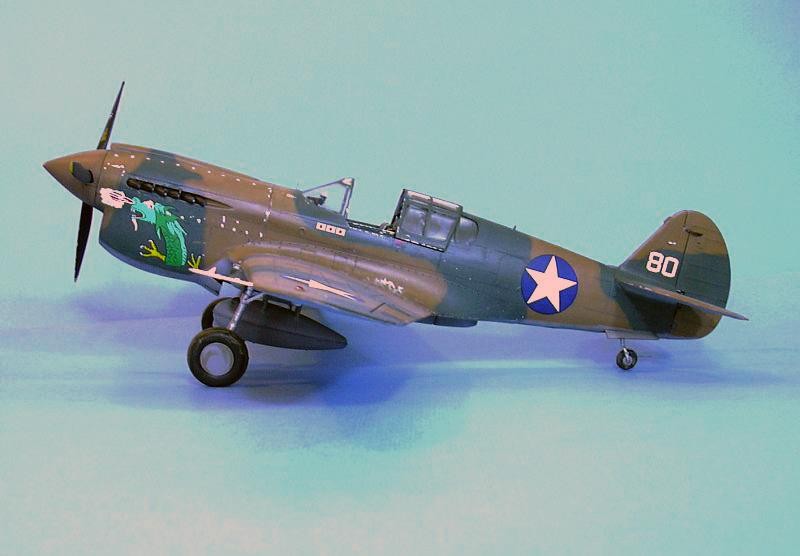
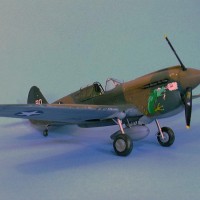
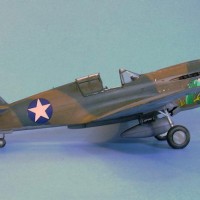
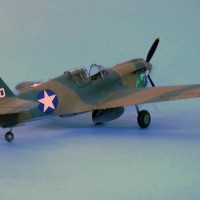
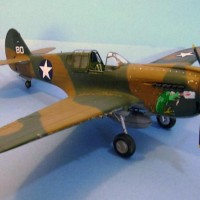
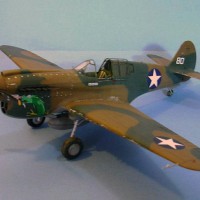
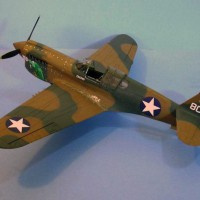
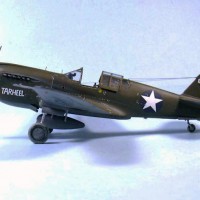
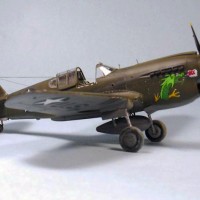
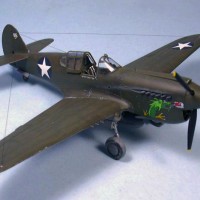
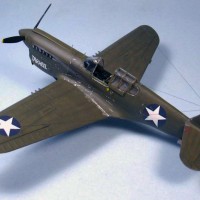
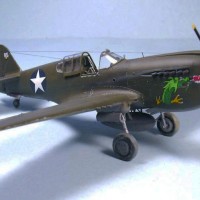
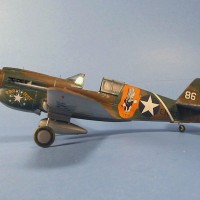
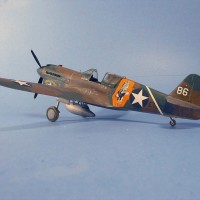
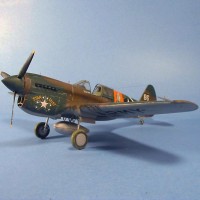
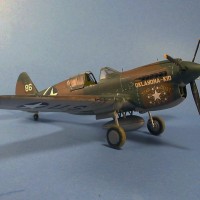
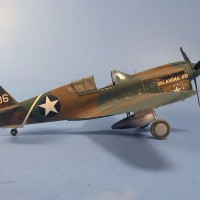
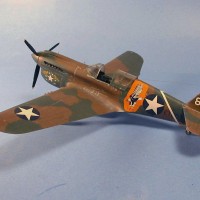
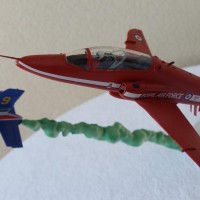

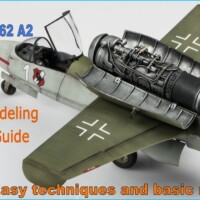

Nice presentation, TC...one of the better ones I've seen. I like it a lot.
Really nice group, Tom! Great photos and narrative, too.
Great looking aircraft and as always a great story
Tom, can't have too many P-40s, Interesting info on these guys, Thanks for sharing !
Hello Tom,
Thanks for the long text. What a history. Makes the models so much more alive.
I especially like some of the decals. Very colorful.
Regards, Dirk / The Netherlands.
Excellent read Tom. Well done.
Great builds, and narrative!
Tom, good looking P-40 collection. The back story is just as good. Early 1942 was a tough time for the Allies. Eventually, production caught up, and we ground the enemy down.
Very nice trio of Warhawks Tom. Star Dust is my favorite of the bunch!
fantastic!
great presentation and superb models mate.
Well done!
Impressive collection of P40-Es.
Tom, nice work and very nice article. I don't remember if I've told you, but I went to High School with "Whispering John" Landers' daughter.
Very interesting - I met him at the 1984 AFAA Convention.